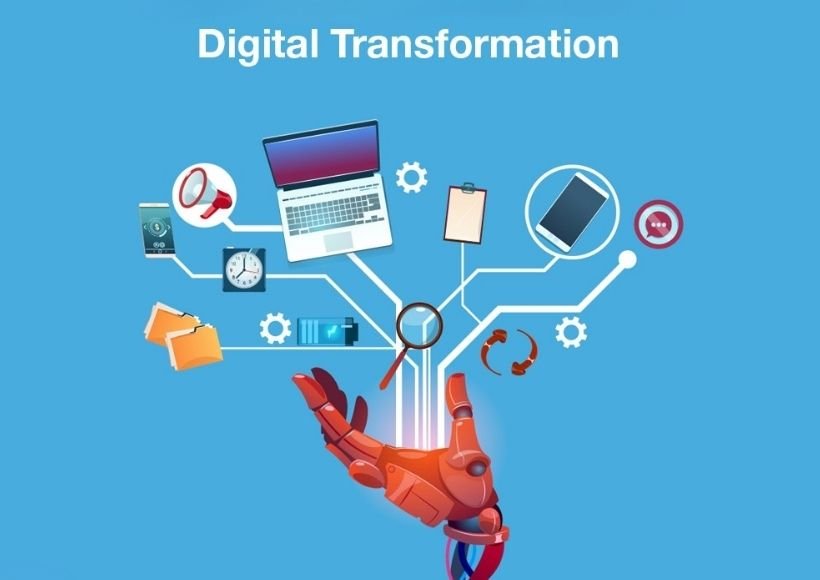How To Achieve And Efficiently Your Digital Transformation?

Table of Contents
Step 1: Information
How to develop a strategy or define objectives without knowing the tools and their effectiveness?
To achieve the best digital transformation, it is imperative that the management team, in the first place, and the company as a whole, acquire knowledge about digital tools.
What tools are there?
What are they for?
In this step, it will be helpful to present to the leader examples of solutions from other companies (direct competitors, from the same sector, or any other activity) to understand what can represent an operational and efficient ecosystem.
It will sometimes be necessary to demystify specific tools that may seem complex or unnecessary at first glance but often form part of a global scheme.
- Is it complicated to understand them?
- Are we able to put them in place?
- Aren’t they suitable for larger companies?
Step 2: Objectives and Challenges
The management team will have to think about the practical and economic objectives of implementing these tools, putting customers and employees at the center of their thinking.
It will be a question of having this global strategic reflection by answering the following questions:
What are our goals, and when? (Short, medium and long term)
What do we expect in terms of image? (Internally and externally)
How to optimize the work of the teams? (Saving time, not losing information, simplification)
What business can we generate? (Acquisition of new customers, development of existing customers)
At this stage, the important thing will not necessarily be to provide ready-made answers, but above all, to ask the right questions.
Step 3: Organization
Who will achieve this digital transformation in the company?
It will be necessary to define the roles of each leader and collaborator to organize the transition as well as possible.
It will also be necessary to make everyone adhere to the project:
- by giving clear objectives
- by avoiding that there are two essential brakes to the change (which would come to block the mechanics)
No one should be overlooked. The whole chain must be involved for more efficiency.
Always keep in mind that in the end, it is the end-users or the customers who will give meaning to the digital transformation.
The customer and user experience must be central throughout the process.
Step 4: Training
Employee training will be essential.
The more employees are trained, the more they will understand the value of the new tools and will even be the vector to others of positive information on changes.
Beyond the training on the tools themselves, it will be necessary to explain the issues and what they will bring at each level, for the customer, for the collaborators among themselves.
It will be necessary to highlight all the positive aspects of the change.
It is at the level of training that membership will take place. It is essential not to neglect this step and take the time to support employees who will have to take this training as a positive vector and not a constraint.
Step 5: Implementation
For the implementation, beyond the team that will be responsible for organizing the transformation and putting it in place, it will be necessary to identify the right service providers to carry out the various tools:
- Website
- Extranet
- Intranet
- CRM
- Mobile Application
- Natural Referencing (SEO) And Adwords Campaign
It is preferable to identify global agencies, which will make it possible to be more efficient and involved rather than having several providers who will sometimes have difficulty talking to each other because they are untrained or competitive.
Step 6: Communication
It is not only a question of putting the tools in place, and we must, of course, use them and not neglect to promote them.
Once the tools are in place, it will be a question of communicating well with two audiences:
- internally: with employees
- externally: with customers
The digital transformation goes through a crucial phase externally:
- informing customers through personalized mailings
- communicating on the website and social networks
- using any other means of communication
A tool will only have meaning because it is known to employees and customers.
This step will be essential for the adhesion of the most significant number.
Step 7: Assessment and adaptation
Once everything is in place, it will be essential to assess the new tools and the overall operation.
This means that it is necessary to include indicators in the solutions and collect analytical data from employees and customers on the use and effectiveness of new tools.
Finally, once these analyses are carried out, it will be necessary to have in mind to adapt the tools or even modify them in depth so that they meet even more expectations and fit nicely into each other.
The solutions should not be dogmatic, and they should evolve over time and constantly adapt to competition, service, and the new tools that will emerge.
In conclusion :
Digital transformation is a fundamental strategic issue today in the business world.
It profoundly modifies balances, methods, and interactions.
Customers and users must always be placed at the center of the thinking for maximum efficiency.
Digital transformation is an opportunity for each company to adapt and develop.
The best way to be successful is to be accompanied
Also Read : How Blockchain Technology Works?
